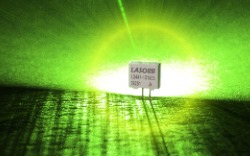|
The problem with laser diodes
Laser diodes are very fast devices that react
rapidly to changing voltage and current. While this is a benefit in
applications such as signaling, it is also a potential liability. Laser
diodes are vulnerable to electrostatic discharge (ESD) events and power
surges. Blu-ray and low-power red laser diodes are particularly
susceptible to voltage spikes, since any increase in applied voltage
beyond normal operating parameters will cause both optical and electrical
overstress.
Anecdotal evidence suggests that many laser diodes
fail long before their life expectancy. One reason is ESD and power surges
generated during power on/off cycles. Voltage spikes are often produced at
these times, and their cumulative effect on laser diodes is detrimental.
 Why
common ESD protection measures don't protect laser diodes Why
common ESD protection measures don't protect laser diodes
Existing design solutions for ESD and
surge protection don't work well -- or at all -- for laser diodes. In
fact, in our testing (shown at right),
none of the commonly employed methods for ESD
protection are reliable for laser diodes.
A common failing of existing methods
is to exceed the normal operating voltage of the laser diode, thus
allowing excessive forward-bias.
What is needed
Based on our extensive testing and evaluation, we
determined that a new method of protecting laser diodes was needed. A
hybrid component could keep spikes from exceeding the diode's normal
operating voltage, and would also absorb high energy in the circuit until
ESD or power surge subsides current was shunted way from the diode.
The
LASORB solution
 To solve the ESD problem, in 2008 Pangolin Laser Systems developed an
electrical component called LASORB. The word
LASORB
is a combination of the words “LASER”
and “ESD ABSORBER”.
The LASORB component is easy for engineers to implement because it is
small and can simply be connected directly to the pins of the laser diode. To solve the ESD problem, in 2008 Pangolin Laser Systems developed an
electrical component called LASORB. The word
LASORB
is a combination of the words “LASER”
and “ESD ABSORBER”.
The LASORB component is easy for engineers to implement because it is
small and can simply be connected directly to the pins of the laser diode.
How LASORB works
LASORB's primary means of protection is a slew-rate detector that monitors
the voltage across the pins of the laser diode. If there is a fast
change-of-voltage condition detected, this triggers LASORB to aggressively
conduct the voltage (and thus current) away from the laser diode. The
conduction is initiated very rapidly – in some cases less than one
nanosecond. The conduction can last from several microseconds, to tens of
microseconds.
|
"In our testing we have found LASORB
to be 100%
effective
at protecting laser diodes from
positive-ESD events up to 15kV, when using the human body model
associated with ANSI/ESD STM5.1 and IEC 61340-3-1. We have also
found that LASORB is able to protect all laser diodes from
negative-ESD up to 15kV when using the human body model associated
with ANSI/ESD STM5.1 and IEC 61340-3-1 as well as IEC 61000-4-2."
For details on testing procedures,
see our datasheets. |
The change-of-voltage approach is a very good
principle to use for laser diodes because, under ordinary circumstances,
even during modulation the voltage across laser diode pins does not change
very much. Therefore any change of voltage – especially a fast change of
voltage – is an abnormal event, something that happens only during ESD or
other types of electrical faults.
Customizable to match diode requirements
.jpg) To allow for complete flexibility and customization
of individual laser diode requirements, the LASORB component is implemented
as a hybrid, containing active silicon and passive components. And as a
side-effect of the makeup of this hybrid component, LASORB also offers
protection from reverse bias conditions, thus allowing LASORB to offer
complete protection of the laser diode from a variety of electrical
faults. To allow for complete flexibility and customization
of individual laser diode requirements, the LASORB component is implemented
as a hybrid, containing active silicon and passive components. And as a
side-effect of the makeup of this hybrid component, LASORB also offers
protection from reverse bias conditions, thus allowing LASORB to offer
complete protection of the laser diode from a variety of electrical
faults.
LASORB is available as a small, through-hole
component, which costs between $2 and $8, depending on the quantity.
Engineers can choose from several LASORB part numbers that dictate the
actual slew rate, surge conduction time and maximum operating voltage.
 For
additional information For
additional information
LASORB datasheets are
here
For pricing and ordering information,
click here.
This webpage has a technical description
of LASORB's approach to ESD protection. It includes a description of the
LASORB circuit symbol (shown at right).
A
Photonics Spectra
article gives a good overview of how
LASORB works to protect laser diodes from ESD.
|
